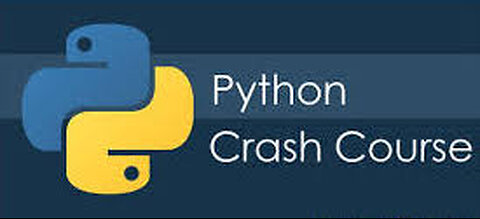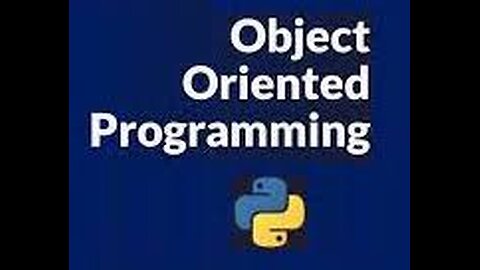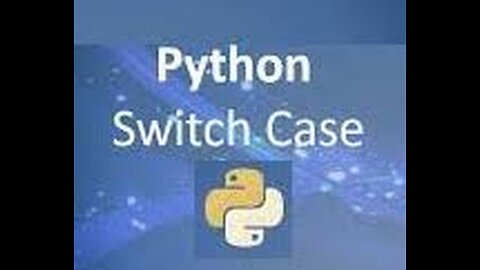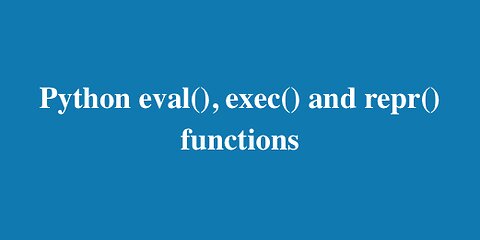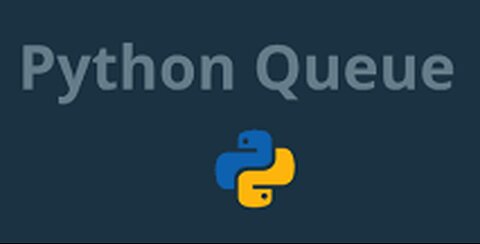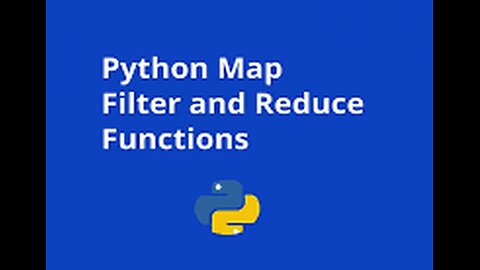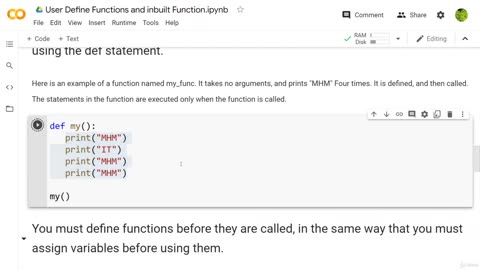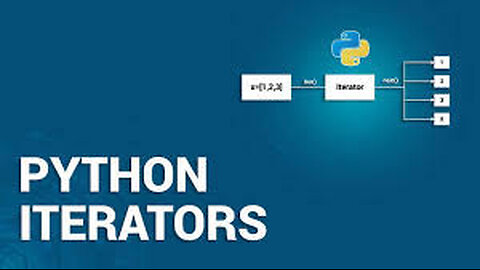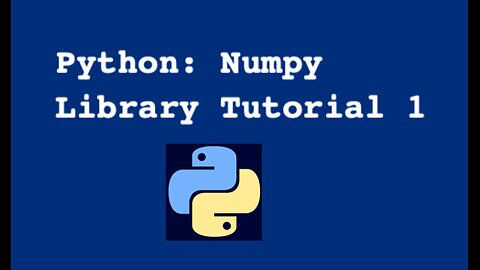
-
37. Python: NumPy Library Tutorial (1)
 Python Beyond Basics for Machine Learning, Data Science, AINumPy is an open source mathematical and scientific computing library for Python programming tasks. The name NumPy is shorthand for Numerical Python. The NumPy library offers a collection of high-level mathematical functions including support for multi-dimensional arrays, masked arrays and matrices.11 views
Python Beyond Basics for Machine Learning, Data Science, AINumPy is an open source mathematical and scientific computing library for Python programming tasks. The name NumPy is shorthand for Numerical Python. The NumPy library offers a collection of high-level mathematical functions including support for multi-dimensional arrays, masked arrays and matrices.11 views -
36. Python Crash Course
 Python Beyond Basics for Machine Learning, Data Science, AIOverall review for Videos from 2 to 3531 views
Python Beyond Basics for Machine Learning, Data Science, AIOverall review for Videos from 2 to 3531 views -
35. Python: Object Oriented Programming (OOP)
 Python Beyond Basics for Machine Learning, Data Science, AIPython Object-Oriented Programming (OOP) is a programming paradigm that organizes code into objects, which are instances of classes. It allows for better code reuse, modularity, and organization.47 views
Python Beyond Basics for Machine Learning, Data Science, AIPython Object-Oriented Programming (OOP) is a programming paradigm that organizes code into objects, which are instances of classes. It allows for better code reuse, modularity, and organization.47 views -
33. Python: Switch Case
 Python Beyond Basics for Machine Learning, Data Science, AIThe switch-case statement is not a built-in feature in Python, but it can be implemented using a combination of if-elif-else statements, classes, or using a dictionary that maps the cases to its corresponding behavior.100 views
Python Beyond Basics for Machine Learning, Data Science, AIThe switch-case statement is not a built-in feature in Python, but it can be implemented using a combination of if-elif-else statements, classes, or using a dictionary that maps the cases to its corresponding behavior.100 views -
33. Python: eval(),exec(),repr() function
 Python Beyond Basics for Machine Learning, Data Science, AI* The eval() function evaluates the specified expression, if the expression is a legal Python statement, it will be executed. * The exec() function executes the specified Python code. The exec() function accepts large blocks of code, unlike the eval() function which only accepts a single expression. * The repr() function returns a string containing a printable representation of an object.110 views 1 comment
Python Beyond Basics for Machine Learning, Data Science, AI* The eval() function evaluates the specified expression, if the expression is a legal Python statement, it will be executed. * The exec() function executes the specified Python code. The exec() function accepts large blocks of code, unlike the eval() function which only accepts a single expression. * The repr() function returns a string containing a printable representation of an object.110 views 1 comment -
31. Python: isinstance, Use of format, Timeit, round, Slice and abs
 Python Beyond Basics for Machine Learning, Data Science, AI1. isinstance() function returns True if the specified object is of the specified type, otherwise False. If the type parameter is a tuple, this function will return True if the object is one of the types in the tuple. 2. format() method formats the specified value(s) and insert them inside the string's placeholder. The placeholder is defined using curly brackets: {}. Read more about the placeholders in the Placeholder section below. format() method returns the formatted string. 3. timeit() method measure execution time of small code snippets. This module provides a simple way to time small bits of Python code. 4. round() function returns a floating point number that is a rounded version of the specified number, with the specified number of decimals. The default number of decimals is 0, meaning that the function will return the nearest integer. 5. slice() function returns a slice object. A slice object is used to specify how to slice a sequence. You can specify where to start the slicing, and where to end. You can also specify the step, which allows you to e.g. slice only every other item. 6. abs() function returns the absolute value of the specified number.125 views 1 comment
Python Beyond Basics for Machine Learning, Data Science, AI1. isinstance() function returns True if the specified object is of the specified type, otherwise False. If the type parameter is a tuple, this function will return True if the object is one of the types in the tuple. 2. format() method formats the specified value(s) and insert them inside the string's placeholder. The placeholder is defined using curly brackets: {}. Read more about the placeholders in the Placeholder section below. format() method returns the formatted string. 3. timeit() method measure execution time of small code snippets. This module provides a simple way to time small bits of Python code. 4. round() function returns a floating point number that is a rounded version of the specified number, with the specified number of decimals. The default number of decimals is 0, meaning that the function will return the nearest integer. 5. slice() function returns a slice object. A slice object is used to specify how to slice a sequence. You can specify where to start the slicing, and where to end. You can also specify the step, which allows you to e.g. slice only every other item. 6. abs() function returns the absolute value of the specified number.125 views 1 comment -
30. Python Queue
 Python Beyond Basics for Machine Learning, Data Science, AIIt is an in-built module for implementing a queue in Python. You can use different functions available in the module to perform operations on a queue. Below is an example of implementing a queue with the help of a queue, along with the use of different functions.242 views 1 comment
Python Beyond Basics for Machine Learning, Data Science, AIIt is an in-built module for implementing a queue in Python. You can use different functions available in the module to perform operations on a queue. Below is an example of implementing a queue with the help of a queue, along with the use of different functions.242 views 1 comment -
29. Python: Lambda, Map, Filter and Reduce Function.
 Python Beyond Basics for Machine Learning, Data Science, AITo work with map(), the lambda should have one parameter in, representing one element from the source list. Choose a suitable name for the parameter, like n for a list of numbers, s for a list of strings. The result of map() is an "iterable" map object which mostly works like a list, but it does not print.198 views
Python Beyond Basics for Machine Learning, Data Science, AITo work with map(), the lambda should have one parameter in, representing one element from the source list. Choose a suitable name for the parameter, like n for a list of numbers, s for a list of strings. The result of map() is an "iterable" map object which mostly works like a list, but it does not print.198 views -
24. Python: User-defined functions and Inbuilt functions
 Python Beyond Basics for Machine Learning, Data Science, AIIf you define the function yourself, it is a user-defined function. On the other hand, the Python function that come along with Python are known as in-built functions. All the functions apart from in-built functions and library functions come under the category of user-defined functions.112 views
Python Beyond Basics for Machine Learning, Data Science, AIIf you define the function yourself, it is a user-defined function. On the other hand, the Python function that come along with Python are known as in-built functions. All the functions apart from in-built functions and library functions come under the category of user-defined functions.112 views -
25. Python: iterator
 Python Beyond Basics for Machine Learning, Data Science, AIAn iterator is an object that contains a countable number of values. An iterator is an object that can be iterated upon, meaning that you can traverse through all the values. Technically, in Python, an iterator is an object which implements the iterator protocol, which consist of the methods __iter__() and __next__().132 views
Python Beyond Basics for Machine Learning, Data Science, AIAn iterator is an object that contains a countable number of values. An iterator is an object that can be iterated upon, meaning that you can traverse through all the values. Technically, in Python, an iterator is an object which implements the iterator protocol, which consist of the methods __iter__() and __next__().132 views
